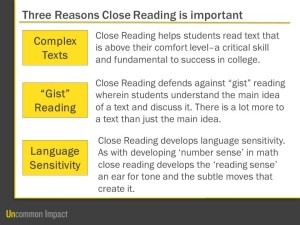03.10.16Three Reasons Why Close Reading is Important
 Chapter two of Reading Reconsidered discusses Close Reading. There’s a lot to discuss, some of which I’ve shared in other blog posts (also here and here). But here, I just want to share the rationale. To Erica Colleen and me, there are three especially compelling reasons why Close Reading is so important:
Chapter two of Reading Reconsidered discusses Close Reading. There’s a lot to discuss, some of which I’ve shared in other blog posts (also here and here). But here, I just want to share the rationale. To Erica Colleen and me, there are three especially compelling reasons why Close Reading is so important:
First, Close Reading helps defend against “gist” readings—interpretations and discussions that are “based on” the text, but not grounded in a comprehensive understanding of it. Students will not succeed if they can observe in only a general sense that Hamlet is unhappy, or summarize the Bill of Rights broadly but not understand the specific language used to frame each individual right, or understand, generally, that glucose levels in the blood affect health, but not how. Close Reading ensures that students are able to glean specific and comprehensive understanding from even very difficult texts.
Second, Close Reading is the tool that allows students to read text that is over their heads—one of the fundamental experiences of attending (or preparing for) college. Reading that is frequently demanding and often done alone, generally without the safety net of peers to discuss it, is the way much learning takes place there. If students can read and learn from what is challenging and unfamiliar, the world is open to them; if they are intimidated by texts that could enlighten them, their horizons are limited. Even though it can be challenging to teach students to read outside their comfort zone, it is folly not to.
Finally, Close Reading develops “language sense.” It develops in students an “ear” for word, syntax, rhythm and structure that is applicable across texts. The ear for satire you sharpen in reading Roald Dahl helps you read Jonathan Swift years later.
